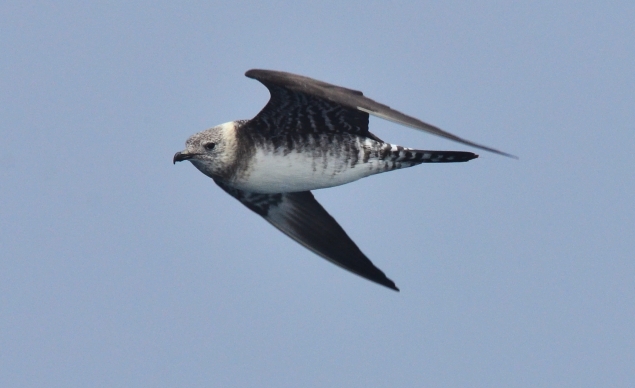
Each pelagic trip is a different beast. My first west coast boat of the year was back on August 30, out of Bodega Bay. Much of the trip was problematic for finding birds...too much swell and too much fog. The seas were ideal for finding a Pterodroma flinging itself off of wave crests up in to the air, but of course we did not encounter any such thing. Some vomiting occurred...typical.
What really saved the trip was the two oil slicks (the fish they call Menhaden...don't tell me you thought otherwise) we put out. The first slick in particular brought in huge numbers of birds that we didn't even know were out there. Tubenoses have an incredible sense of smell, so any hungry bird in the area would come in to check it out, which in turn brought in curious sight-dependent birds like jaegers and Sabine's Gulls. The second slick was conveniently applied next to a small raft of storm-petrels (including Black and Fork-tailed, above), who were obliged to investigate.
Part of the large Sabine's Gull flock that came in to the first slick. That wing pattern holds a special place in my heart.
See what I mean? What a gull.
At the first slick, we had a FLOCK of Long-tailed Jaegers hanging out next to the boat, harassing the Sabine's Gulls. I think the Bird Gods were wise to add the yellow blush on adult birds.
In fact, we had every possible plumage of Long-tailed Jaeger in the flock, including an adult that still had its breeding rectrices (which I was unable to crush properly). This is a second-year bird, retaining a bit of brown mottling on the breast.
Here is a "light morph" juvenile, with pale head and blonde collar.
"Dark morph" juvenile. Note how little white there is in the primaries, a strong field mark for this species.
Of course, no fall pelagic is really complete without Buller's Shearwater. The first oil slick brought in a flock of these soothing shearwaters as well. Like Sabine's Gull, viewing the upperwing pattern triggers strong emotional responses, on many levels.
At oil slick #2, there were a number of Fork-tailed Storm-Petrels that came to visit. The dark coverts of the underwing contrast strongly with the rest of the bird, even in thick fog.
The Fork-taileds came hella close to the boat, even eating a bit of popcorn on the water. And yes, Fork-tailed Storm-Petrel is an astoundingly stupid name for this bird. Who in their right mind would look at this bird and think, "Goodness, I am absolutely unable ignore the shallow fork of the tail. I cannot look away. There is simply no other distinctive feature on this bird that is more descriptive. Nothing that makes it unique among the storm-petrels of the North Pacific. Forevermore, this species shall be known to the masses as Fork-tailed Storm-Petrel"?
Black Storm-Petrel is yet another "fork-tailed" species with a slightly better name. Like Fork-tailed, they are a bit braver than their Ashy counterparts, swooping in close to the boat for crippling looks.
I think this photo really conveys how large and long-winged these birds are compared to the other puny storm-petrels they typically accompany in central/northern California. Too bad the fog was so thick, I really could have put the crush on these birds.
Being in the presence of Blue Whales really puts things in perspective. We are small and shitty organisms compared to these behemoths.
At the end of the day, the Bodega trip was a lot of fun, although we were severely handicapped by the waves and weather. Aside from the photographed species above, South Polar Skua, Wilson's Storm-Petrels and more Red Phalaropes than I have ever seen were highlights. Looking forward to going out again in two weeks!












I think 'leviathan' is a better descriptor of Blue Whales than 'behemoth'. Behemoth was the land-monster God created to demonstrate humankind's inferiority, whereas Leviathan was the sea-monster created for the same purpose:
ReplyDelete"Behold now the behemoth that I have made with you; he eats grass like cattle.
Behold now his strength is in his loins and his power is in the navel of his belly.
His tail sways like a cedar; the sinews of his thighs are knit together.
His limbs are as strong as copper, his bones as a load of iron.
His is the first of God's ways; only his Maker can draw His sword."
Biblical descriptions are ridiculous.
That is ridiculous. Why would his power be in the navel of his belly? No one keeps power there. But we know that whales are actually land monsters that turned into sea monsters, so there.
DeleteOooh, snap. I stand corrected.
Delete"Goodness, I am absolutely unable ignore the shallow fork of the tail. I cannot look away. There is simply no other distinctive feature on this bird that is more descriptive. Nothing that makes it unique among the storm-petrels of the North Pacific. Forevermore, this species shall be known to the masses as Fork-tailed Storm-Petrel"
ReplyDeleteHAHAHAHAHAHAHAHAHA
I actually never realized what a terrible name that was until a couple days ago. How embarrassing.
DeleteSmall and shitty indeed. All hail Big Blue.
ReplyDeleteWhen I was studying my flashcards and looked at Fork-tailed Storm-Petrel I thought, oh this should be easy, there are probably no other storm-petrels with forked tails...